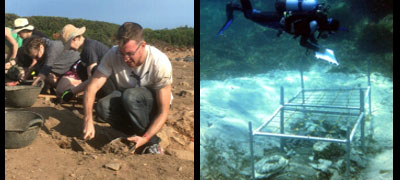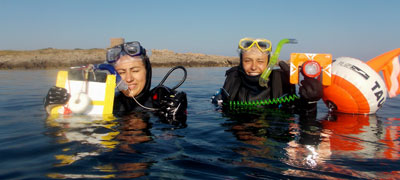AT THE MOMENT REGISTRATION IS CLOSED TO THE COURSES BELOW. We want to challenge COVID-19 and we are going to start promoting our projects that will start in May 2021. We will do it slowly, and progressively if conditions improve, waiting to see how this pandemic evolves. Check which courses you can enroll in
013.Discover Amphora & Shipwrecks in the Underwater Port of Sanitja (Menorca, Spain).
 This course focuses on underwater survey, Mediterranean ship building techniques and conservation. The aim is to identify underwater structures of the Roman city of Sanisera and shipwrecks, as well as anchors and amphorae related to those shipwrecks and its cargoes.
This course focuses on underwater survey, Mediterranean ship building techniques and conservation. The aim is to identify underwater structures of the Roman city of Sanisera and shipwrecks, as well as anchors and amphorae related to those shipwrecks and its cargoes.
![]() General Information What you will learn Useful Information Staff Sessions & Cost
General Information What you will learn Useful Information Staff Sessions & Cost
014. Explore Underwater Pompeii (Baia Underwater Park, Naples Bay – Italy) & Discover Amphora & Shipwrecks in the Underwater Port of Sanitja. (Menorca – Spain)
 This course focuses on underwater survey in the Ancient Port of Sanisera, Menorca Spain, Mediterranean ship building techniques and studying the submerged archaeological remains of Portus Iulius and the Roman villas of the Baia Underwater Park, Naples Bay, Italy. The aim is to identify underwater structures of the Roman city of Sanisera and shipwrecks, as well as anchors and amphorae related to those shipwrecks and its cargoes. Then students will travel to Naples, Italy to study the ruins of ancient Roman harbour.
This course focuses on underwater survey in the Ancient Port of Sanisera, Menorca Spain, Mediterranean ship building techniques and studying the submerged archaeological remains of Portus Iulius and the Roman villas of the Baia Underwater Park, Naples Bay, Italy. The aim is to identify underwater structures of the Roman city of Sanisera and shipwrecks, as well as anchors and amphorae related to those shipwrecks and its cargoes. Then students will travel to Naples, Italy to study the ruins of ancient Roman harbour.
![]() General Information What you will learn Useful Information Staff Sessions & Cost
General Information What you will learn Useful Information Staff Sessions & Cost
027 Surveying the Roman Mediterranean Ports: Portus Iulius (Italy) & Sanisera (Spain)
In the Roman port of Sanisera (Menorca , Spain ), in a privileged landscape, you can dive into different depths with wide visibility, learning how to recognize remains of amphorae, anchors and Roman shipwrecks with which you will practice the survey method and the applied registration system (photographic documentation in 2D and 3D , drawing, classification of amphorae, ... ).
In one of the most unique ports of the Roman world, Portus Iulius (Naples, Italy), you will investigate a unique and exceptional seabed, one of the best in the field of underwater archeology
![]() General Information What you will learn Useful Information Staff Session & Cost
General Information What you will learn Useful Information Staff Session & Cost
029 Research and Underwater Survey in Portus Iulius ('Underwater Pompeii', Italy)
 Participating in this course is a unique opportunity. Portus Iulius was the quintessential port of Rome in the period of greatest splendor of their empire. We absolutely recommend this program to any college student who wants to enter in the field of underwater archeology.
Participating in this course is a unique opportunity. Portus Iulius was the quintessential port of Rome in the period of greatest splendor of their empire. We absolutely recommend this program to any college student who wants to enter in the field of underwater archeology.
![]() General Information What you will learn Useful Information Staff Session & Cost
General Information What you will learn Useful Information Staff Session & Cost
041 Discover the Underwater Archaeology of the Port of Sanitja & Archaeological Techniques of drawing, photography and digital illustration
This program is divided in two main parts. During the first part of the course students will gain experience in underwater archaeological survey, exploring the Ancient Port of Sanitja and the coast of the Cape of Cavalleria. The aim of this project is to identify structures of the Roman city of Sanisera and underwater shipwrecks, as well as the associated cargo including amphora and anchors. During the second part of the course, students will learn the Tools and laboratory techniques used with archaeological material.
![]() General Information What you will learn Useful Information Staff Session & Cost
General Information What you will learn Useful Information Staff Session & Cost
046 Underwater Archaeology in Sanitja harbor & Dig in the Roman city of Sanisera (Menorca, Spain)
The ancient Roman city of Sanisera is located on a natural harbor. For this reason, we are lucky that the land excavations and the underwater activities take place in the same area, allowing us to develop projects in the terrestrial and marine environment, using different methodologies and techniques with a great team of professionals and experts. Also, you can learn from the beginning excavation techniques and methodology. During the excavation, you will find archaeological remains from the classical period including Roman pottery, amphorae, glass, etc. that you will learn how to identify in the laboratory. The course lasts 18 days and will be divided into two different periods. The first nine days will be dedicated to underwater archaeology activities while the rest of the course will be focused on everything that is related to a land excavation.
![]() General Information What you will learn Useful Information Staff Session & Cost
General Information What you will learn Useful Information Staff Session & Cost
047 Advanced Underwater Archaeology in the Mediterranean Island of Menorca (Spain)
In 2018 we will start a survey program in the deeper and unknown waters from the North coast of the island. We will dive up to 30 meters at some distance from the coast, assisted with a boat. We will be able to discover new shipwrecks of the Roman period or from the 16th to 19th Centuries. There will be a minimum of 8 immersions focusing on underwater archaeological survey exploring a submerged valley where some remains of wrecks can be found through survey techniques, and always diving between 18 and 30 meters deep.
![]() General Information What you will learn Useful Information Staff Session & Cost
General Information What you will learn Useful Information Staff Session & Cost
048 Extended Underwater Archaeology Program (Menorca, Balearic Island, Spain)
This course offered by the Sanisera Archaeology Institute is designed to teach with precision this field of research. If you are interested in learning underwater survey techniques and methodology and apply them in a Roman port where you will find amphorae, anchors and the remains of shipwrecks, then this is a good option for you. After more than 10 years of survey, our research team has new objectives, focused in a survey that will be held underwater, more than 18 meters deep. Located in the north coast of Menorca and nearby the Roman city of Sanisera, we consider essential to dive up to 30 meters, since there are many possibilities to discover, including more shipwrecks of Roman times or the past centuries.
![]() General Information What you will learn Useful Information Staff Session & Cost
General Information What you will learn Useful Information Staff Session & Cost
049 Underwater excavation of a shipwreck. Bougianen Project (Menorca, Spain)
The shipwreck is that they correspond to a vessel of the 19th century, which, according to a story at the time, recounted the wreck of an Italian schooner called Bougianen. The remains of the shipwreck are located in an ideal position to carry out an underwater excavation. Since the excavation will be only 6 meters deep and in temperate waters, there will be a minimum of 12 immersions (two dives almost every day) about 45 minutes each.
![]() General Information What you will learn Useful Information Staff Session & Cost
General Information What you will learn Useful Information Staff Session & Cost












